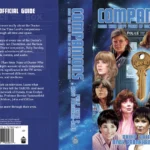We’ve talked about Robert Holmes a lot in the past in these articles, and no doubt will again in the future. Although not his final Doctor Who story, Caves of Androzani is certainly one of his best, and the circumstances that surround it, the development of the Doctor and Peri that had to take place within it and the overall quality of the production results in Caves standing out as the best story of Fifth Doctor’s era.
Regeneration stories are always going to feature in these “Shape of…” articles – we’ve already tackled The Power of the Daleks – simply by their very nature; the shape of Doctor Who changes with each change of Doctor. But here, we have something unique. In a triumph of production management, Caves of Androzani features not only the best script of the era, it is also packed full of some of the best guest actors of the era, the best location shooting, best soundtrack and lighting and, lets face it, the best direction. The visual effects, too, seem to be better than anything in the previous five years of Doctor Who.
Yet this was just 12 months prior to the series’ cancellation. While we’re not going to discuss that particular issue at this point, it is interesting to draw parallels. The differences between the Fifth and Sixth Doctor’s eras are stark as it is, before we even get close to discussing the change in tone, atmosphere, guest appearances, soundtrack and costume. It could even be argued that the amount of effort that obviously went in to creating Caves should have been applied to the succeeding story The Twin Dilemma.
But why, exactly, is Caves important? Well, for starters it’s really, really good. In terms of its quality it’s up there with Seeds of Doom and Inferno, or even later classics like Remembrance of the Daleks or The Unquiet Dead. The script evokes with consummate ease a human colony civilisation, which features an ongoing dispute, gun-running and political duplicity in to which the Doctor and Peri aimlessly stumble.
Holmes even increases the odds by giving us a race against time. Peri and the Doctor are both poisoned by the Spectrox nest. If the Doctor can’t find an antidote, they will both die. Add to this already dramatic mix the archetypes of Sharaz Jek and Trau Morgus, and the tension is electric.
They’re two of Robert Holmes’ most fascinating Doctor Who characters; Jek with his mask, his army of androids and his reserves of the most valuable substance in the nine galaxies Spectrox; and Morgus with his mines, his money, he gun-runners and his captive audience. Extraordinarily compelling performances from Christopher Gable as Sharaz Jek and John Normington as Morgus stand out and provide superb texture to this story, and Doctor Who as a whole.
Graeme Harper’s direction has been largely ignored up to this point, so let’s have a look at a few key points. 1980s Doctor Who was largely bright lights and dry sounds. The country house in The Visitation is obviously a studio set. It’s lit like one, and it sounds like one. But while the cave sets in Androzani are still recognisably sets, the way the lighting is expertly lowered and angled, and the audio reverb that is given to the scenes within the caves allows the viewer to immerse him or herself and care about what is taking place.
While all of these aspects come together in perfect synchronicity, there is still only one leading man, at least until Part Four. Peter Davison expressed at the time his reluctance to leave the show following the experience he had making his final story – but frankly, his performance here couldn’t have been bettered. His Doctor – young, inquisitive, energetic and compassionate – is toned perfectly. As we reach the end of the story, his bravery underlines that the guns waved around by Stotz and his goons don’t make a hero.
The rescued Peri is still sick. Jek is dead. Morgus is dead. The mudbursts are coming. The Doctor is weakening, but he has the antidote, the milk of the queen bat. He picks up Peri and carries her. The TARDIS is waiting and the mudbursts start. (It’s brilliant, isn’t it?! This man is about to die, and he’s risking his life to save a young earth girl because he is responsible for her being there! Well, that’s his story.)
This brings us to the regeneration scene. It’s the end as far as we’re concerned, however. A rehash of the 1981 regeneration, simply, with an unnecessarily smug closing line from the new Doctor. This story ended with the Doctor querying “Is this death…?” as he falls to the TARDIS floor, his body ravaged by the Spectrox Toxaemia. He only has enough of the antidote for Peri.
Caves of Androzani is flawless storytelling. It’s superb direction. Atmospheric lighting, ambitious set design and above all top quality Doctor Who. We wouldn’t see anything on this scale for 21 years. Twenty-one! This is why the story is so loved, admired and remembered.
It is perfect.
Graphic By Simon Holub
Discover more from Kasterborous
Subscribe to get the latest posts sent to your email.









